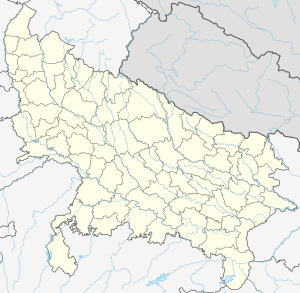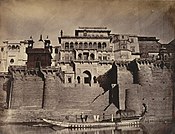
Varanasi division is one of the 18 administrative geographical units of the northern Indian state of Uttar Pradesh. Varanasi city is the administrative headquarters of the division. The division consists of 4 districts, i.e. Varanasi, Chandauli, Ghazipur, and Jaunpur and is loosely equivalent to the Benares State.

Sankat Mochan Hanuman Temple is a Hindu temple in Varanasi, Uttar Pradesh, India and is dedicated to the Hindu God Hanuman. The temple was established by famous Hindu preacher and poet saint Sri Goswami Tulsidas in the early 16th century and is situated on the banks of the Assi river. The deity was named "Sankat Mochan" meaning the "reliever from troubles".

Banaras State initially known as Banaras kingdom or Kashi Kingdom was a kingdom and later princely state under the Narayan Dynasty in what is today Uttar Pradesh, India. On 15 October 1948, Benares' last ruler signed the accession to the Indian Union.
Ramnagar is a city, just outside Varanasi city and a municipal board in Varanasi district in the Indian state of Uttar Pradesh. Ramnagar has a fort known as Ramnagar Fort which is still the residence of King of Varanasi (Benares). He was known as Kashi Naresh meaning king of Kashi and is still regarded by old residents of the city of Varanasi. Ramnagar Fort and its museum are the repository of the history of the kings of Benares and since the 18th century has been the home of Kashi Naresh. Even today the Kashi Naresh is deeply revered by the people of Benares. He is the religious head and the people of Benares consider him the incarnation of Shiva. He is also the chief cultural patron and an essential part of all religious celebrations. Ramnagar is popular for Ramlila that is held annually under the aegis of King of Varanasi

Ramlila is any dramatic folk re-enactment of the life of Rama according to the ancient Hindu epic Ramayana or secondary literature based on it such as the Ramcharitmanas. It particularly refers to the thousands of the Hindu god Rama-related dramatic plays and dance events, that are staged during the annual autumn festival of Navaratri in India. After the enactment of the legendary war between good and evil, the Ramlila celebrations climax in the Vijayadashami (Dussehra) night festivities where the giant grotesque effigies of evil such as of the rakshasa (demon) Ravana are burnt, typically with fireworks.

Maharaja Vibhuti Narayan Singh was the king of Benares, a city considered holy, located in the Indian state of Uttar Pradesh. He was the last Bhumihar Brahmin king of the Kingdom of Kashi.

Yatra, in Indian-origin religions, Hinduism, Buddhism, Jainism and Sikhism, generally means a pilgrimage to holy places such as confluences of sacred rivers, sacred mountains, places associated with Hindu epics such as the Mahabharata and Ramayana, and other sacred pilgrimage sites. Visiting a sacred place is believed by the pilgrim to purify the self and bring one closer to the divine. The journey itself is as important as the destination, and the hardships of travel serve as an act of devotion in themselves.
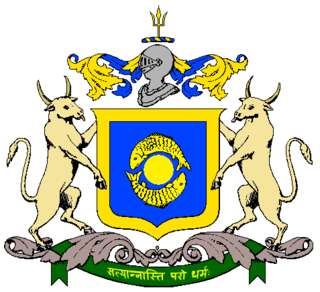
The Narayan dynasty was the ruling family of Benares. After seceding from Awadh, Benares emerged as a kingdom of its own, ruled by Maharaja Balwant Singh in the 18th century. Since then, the family has ruled Benares. They belonged to the Bhumihar Brahmin community. In 1911, Benares became a full-fledged princely state of British India and the Narayan dynasty ruled it as British vassals until they acceded to independent India in 1947.

Prabhu Narayan Singh was ruler of the Benares State, an Indian princely state, from 1889 to 1931. Prabhu Narayan Singh would reign for 42 years as Maharaja; in 1891, he was knighted with the KCIE, later becoming an honorary colonel in the Indian Army.

The Durga Mandir (Temple) is situated in Ramnagar of Banaras (or Varanasi). It is believed that it was built 500 years ago which is under control of royal family of Banaras State currently. This temple is devoted to Hindu deity Durga. The temple has a large stone built pond with it. The Durga Mandir boasts of its fine stone works, which is a fabulous example of north Indian stone work arts.

Situated in the northern part of India, bordering with the capital of India New Delhi, Uttar Pradesh is one of the most popular and an established tourist destination for both Indians and non-Indians alike in India. The most populous state of India, Uttar Pradesh contains many historical monuments and places of religious significance. Geographically, Uttar Pradesh is very diverse, with Himalayan foothills in the extreme north and the Gangetic Plain in the centre. It is also home of India's most visited sites, Hinduism's holiest city, Varanasi. Kumbh city, Prayagraj. Kathak, one of the eight forms of Indian classical dances, originated from Uttar Pradesh. Uttar Pradesh is at the heart of India, hence it is also known as The Heartland of India. Cuisine of Uttar Pradesh like Awadhi cuisine, Mughlai cuisine and Bhojpuri cuisine are very famous not only in India but also many places abroad.

Maharaja Udit Narayan Singh was the eldest surviving son of Maharaj Mahip Narayan Singh, Udit Narayan Singh Sahib Bahadur became the new king of Benares.

The Sapta Puri are a group of seven Hindu tirtha, or holy pilgrimage sites, located in India. Pilgrimage to these sites is said to bless the pilgrim with moksha.
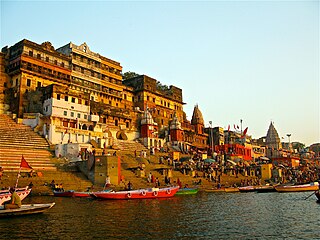
Ghats in Varanasi are riverfront steps leading to the banks of the Ganges river. The city has 84 ghats. Most of the ghats are bathing and puja ceremonial ghats, while two ghats, Manikarnika and Harishchandra, are used exclusively as cremation sites.
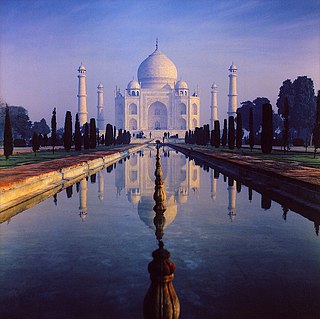
The architecture of Uttar Pradesh demonstrates a diverse and eclectic combination of Buddhist, Hindu, Indo-Islamic, and Indo-European architectural styles. Three of its architectural monuments—the Taj Mahal, the Agra Fort, as well as the township of Fatehpur Sikri founded by the Mughal emperor Akbar—are designated UNESCO World Heritage Sites. The architectural structures in Uttar Pradesh include ancient Buddhist stūpas and vihāras, ancient Buddhist and Hindu monasteries, townships, forts, palaces, temples, mosques, mausoleums, memorials, and other community structures. Uttar Pradesh's architectural structures also include various Hindu temples, Ghats, etc. largely found in ancient cities like Benares (Varanasi), Brindaban (Vrindavan), Mathura, and Prayagraj (Allahabad).
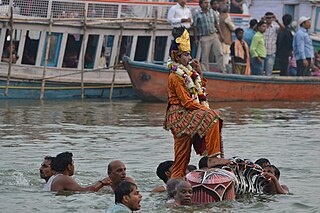
Nag Nathaiya or Nag Nathaiya Leela is a Hindu festival held in the city of Varanasi in Bhojpur-Purvanchal region of India, commemorating the conquest of the god Krishna over the naga (serepnt) Kaliya. The tale is reenacted annually the Tulsi Ghat on the fourth tithi of Kartik's light fortnight, Paksha; which is usually sometime between November and December.

The Dev Deepavali is the festival of Kartik Poornima celebrated in the city of Varanasi in Bhojpuri region of Uttar Pradesh, India. It falls on the full moon of the Hindu month of Kartika and takes place fifteen days after Diwali. The steps of all the ghats on the riverfront of the Ganges River, from Ravidas Ghat at the southern end to Rajghat, are lit with more than a million earthen lamps (diyas) in honour of Ganga, the Ganges, and its presiding goddess. Mythologically, the gods are believed to descend to Earth to bathe in the Ganges on this day. The festival is also observed as Tripura Purnima Snan. The tradition of lighting the lamps on the Dev Deepawali festival day was first started at the Dashashwamedh Ghat by Pandit Kishori Raman Dubey in 1991.
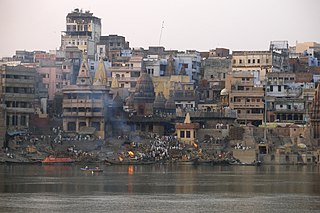
Varanasi is a city on the Ganges river in northern India that has a central place in the traditions of pilgrimage, death, and mourning in the Hindu world. The city has a syncretic tradition of Islamic artisanship that underpins its religious tourism. Located in the middle-Ganges valley in the southeastern part of the state of Uttar Pradesh, Varanasi lies on the left bank of the river. It is 692 kilometres (430 mi) to the southeast of India's capital New Delhi and 320 kilometres (200 mi) to the southeast of the state capital, Lucknow. It lies 121 kilometres (75 mi) downstream of Prayagraj, where the confluence with the Yamuna river is another major Hindu pilgrimage site.
Varanasi, also known as Kashi, is considered as the religious capital of Hinduism. In the Hindu faith, it is the holiest of all of its cities; the four dhams in the four cardinal directions of the country – Badrinath in the north, Puri in the east, Dwarka in the west and Rameshwaram in the south – are all represented in the city in "archetypal forms" as the presiding deities at Badrinath Ghat, Assi's Jagannath Temple area, Shankudhara Pokhra, and Mir Ghat respectively. Other Hindu holy places, such as the Kedarnath at Kedar Ghat, Mathura at Bakaruia Kund or Nakhi Ghat, Prayagraj (Allahadbad) at Dashahvamedha Ghat, Kamakhya (Assam) at Kamachha, Kurukshetra at Kurkukshetra Kund near Asi, and Lake Manasarovar at Mansarovar near Shyameshvara are a part of the city's religious and cultural heritage.

